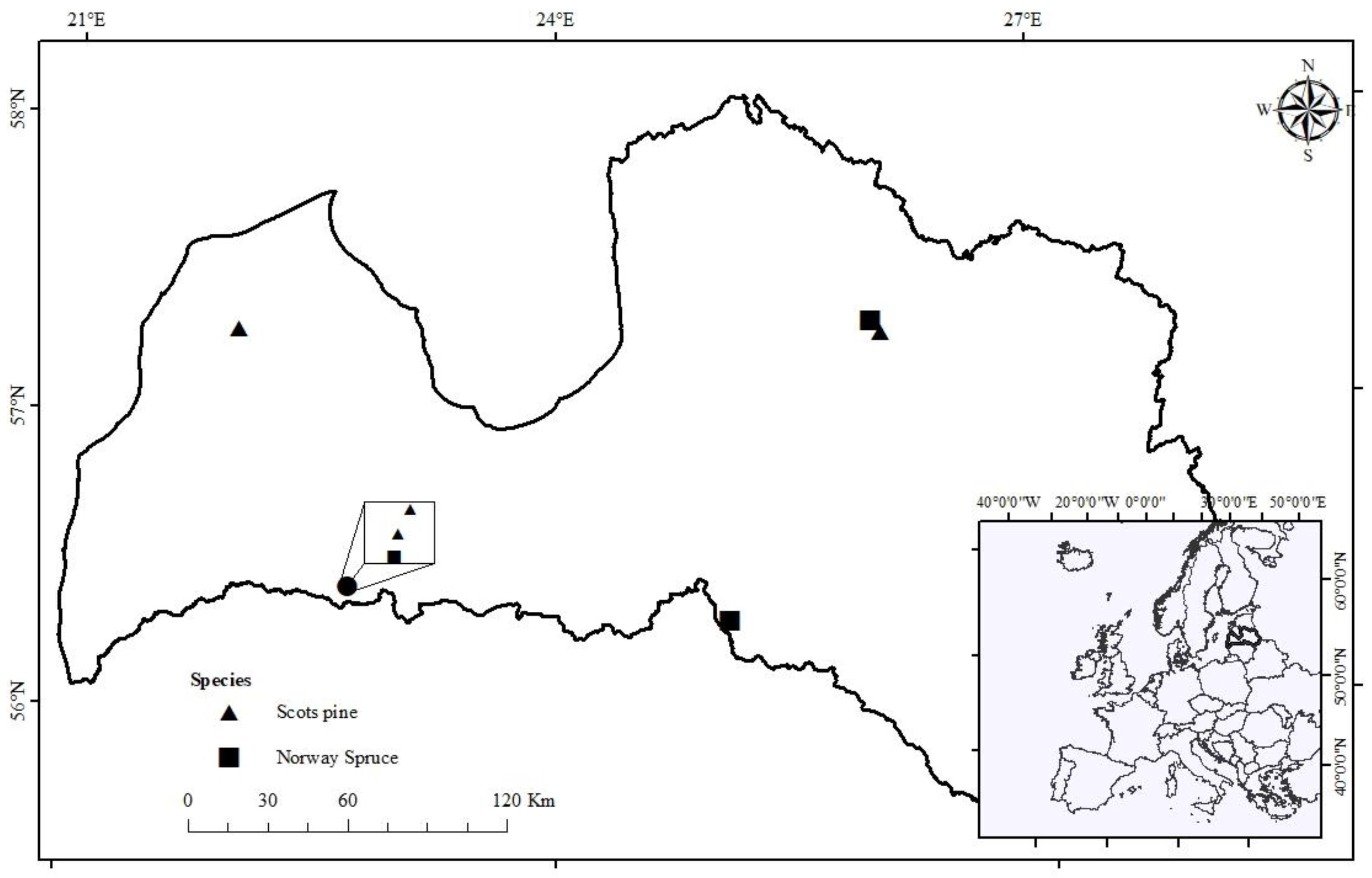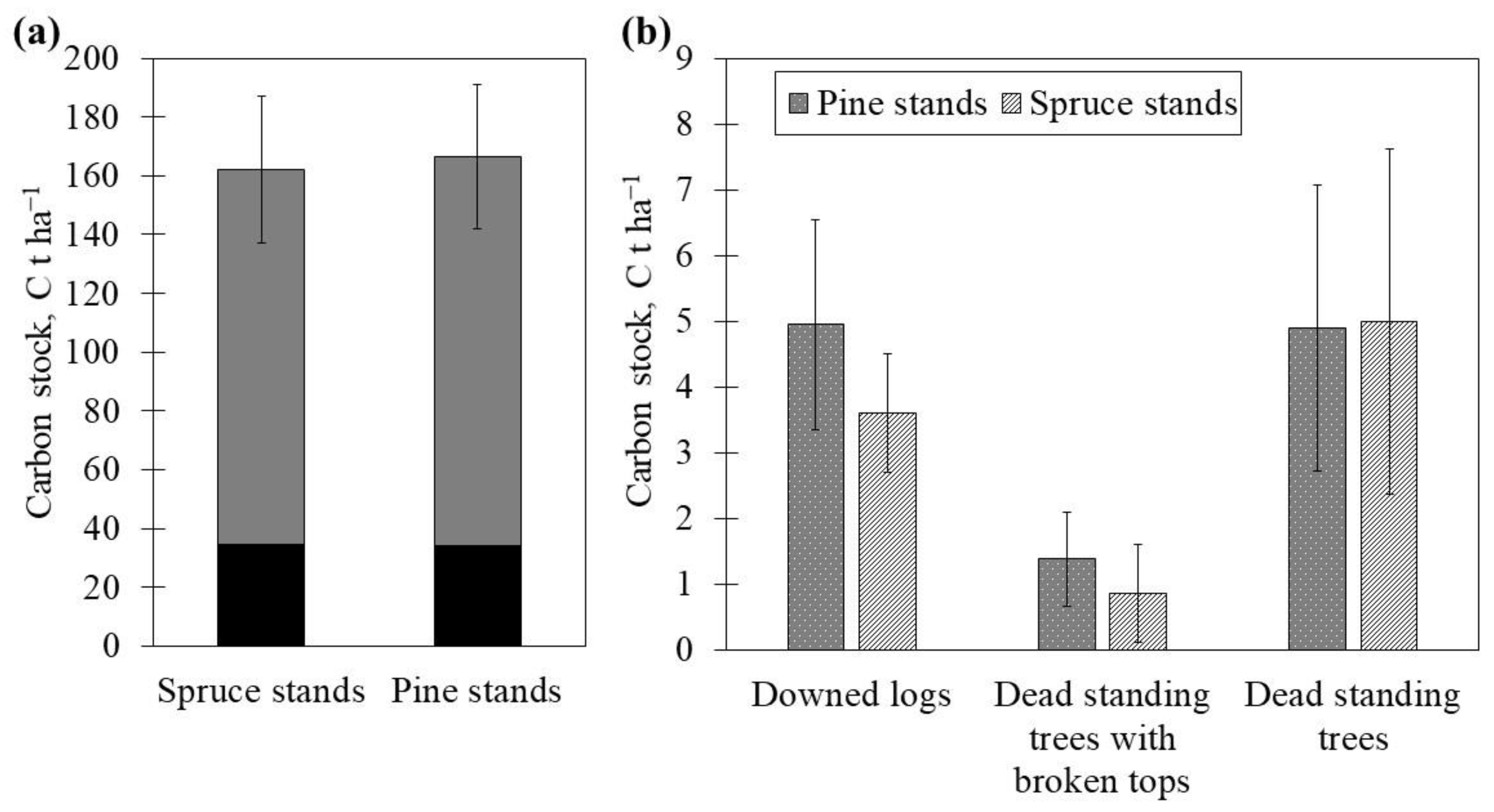Old-Growth Coniferous Stands on Fertile Drained Organic Soil: First Results of Tree Biomass and Deadwood Carbon Stocks in Hemiboreal Latvia
Abstract
:1. Introduction
2. Materials and Methods
3. Results
4. Discussion
Author Contributions
Funding
Institutional Review Board Statement
Informed Consent Statement
Data Availability Statement
Conflicts of Interest
References
- Lupikis, A.; Lazdins, A. Soil carbon stock changes in transitional mire drained for forestry in Latvia: A case study. For. Wood Proc. 2017, 1, 55–61. [Google Scholar] [CrossRef]
- Tubiello, F.N.; Biancalani, R.; Salvatore, M.; Rossi, S.; Conchedda, G. A worldwide assessment of greenhouse gas emissions from drained organic soils. Sustainability 2016, 8, 371. [Google Scholar] [CrossRef] [Green Version]
- Bārdule, A.; Butlers, A.; Lazdiņš, A.; Līcīte, I.; Zvirbulis, U.; Putniņš, R.; Jansons, A.; Adamovičs, A.; Razsma, Ģ. Evaluation of soil organic layers thickness and soil organic carbon stock in hemiboreal forests in Latvia. Forests 2021, 12, 840. [Google Scholar] [CrossRef]
- Minkkinen, K.; Laine, J. Effect of forest drainage on the peat bulk density of pine mires in Finland. Can. J. For. Res. 1998, 28, 178–186. [Google Scholar] [CrossRef]
- Lohila, A.; Laurila, T.; Aro, L.; Aurela, M.; Tuovinen, J.P.; Laine, J.; Minkkinen, K. Carbon dioxide exchange above a 30-year-old Scots pine plantation established on organic-soil cropland. Boreal Environ. Res. 2011, 12, 141–157. [Google Scholar]
- Butlers, A.; Lazdins, A. Carbon stock in litter and organic soil in drained and naturally wet forest lands in Latvia. Proc. Res. Rural. Dev. 2020, 35, 47–54. [Google Scholar] [CrossRef]
- Badalamenti, E.; Battipaglia, G.; Gristina, L.; Novara, A.; Ruhl, J.; Sala, G.; Sapienza, L.; Valentini, R.; La Mantia, T. Carbon stock increases up to old growth forest along a secondary succession in Mediterranean island ecosystems. PLoS ONE 2019, 14, e0220194. [Google Scholar] [CrossRef] [PubMed]
- Berglund, H.; Kuuluvainen, T. Representative boreal forest habitats in northern Europe, and a revised model for ecosystem management and biodiversity conservation. Ambio 2021, 50, 1003–1017. [Google Scholar] [CrossRef]
- Jacob, M.; Bade, C.; Calvete, H.; Dittrich, S.; Leuschner, C.; Hauck, M. Significance of over-mature and decaying trees for carbon stocks in a Central European natural spruce forest. Ecosystems 2013, 16, 336–346. [Google Scholar] [CrossRef] [Green Version]
- Siitonen, J.; Martikainen, P.; Punttila, P.; Rauh, J. Coarse woody debris and stand characteristics in mature managed and old-growth boreal mesic forests in southern Finland. For. Ecol. Manag. 2000, 128, 211–225. [Google Scholar] [CrossRef]
- Ķēniņa, L.; Elferts, D.; Bāders, E.; Jansons, Ā. Carbon pools in a hemiboreal over-mature Norway Spruce stands. Forests 2018, 9, 435. [Google Scholar] [CrossRef] [Green Version]
- Ķēniņa, L.; Jaunslaviete, I.; Liepa, L.; Zute, D.; Jansons, Ā. Carbon pools in old-growth Scots pine stands in hemiboreal Latvia. Forests 2019, 10, 911. [Google Scholar] [CrossRef] [Green Version]
- Šēnhofa, S.; Jaunslaviete, I.; Šņepsts, G.; Jansons, J.; Liepa, L.; Jansons, Ā. Deadwood characteristics in mature and old-growth birch stands and their implications for carbon storage. Forests 2020, 11, 536. [Google Scholar] [CrossRef]
- Kārkliņš, A.; Gemste, I.; Mežals, H.; Nikodemus, O.; Skujāns, R. Taxanomy of Latvia Soils; Latvijas Lauksaimniecības Universitāte: Jelgava, Latvia, 2009; p. 240. [Google Scholar]
- Zālītis, P. The productivity of drained pine forests and pinewood quality. Balt For. 1999, 5, 2–7. [Google Scholar]
- Avotniece, Z.; Aniskeviča, S.; Maļinovskis, E. Climate Change Scenarious for Latvia. Available online: http://www2.meteo.lv/klimatariks/zinojums.pdf (accessed on 27 January 2022).
- Sandström, F.; Petersson, H.; Kruys, N.; Ståhl, G. Biomass conversion factors (density and carbon concentration) by decay classes for dead wood of Pinus sylvestris, Picea abies and Betula spp. in boreal forests of Sweden. For. Ecol. Manag. 2017, 243, 19–27. [Google Scholar] [CrossRef] [Green Version]
- Liepiņš, J.; Lazdiņš, A.; Liepiņš, K. Equations for estimating above– and belowground biomass of Norway spruce, Scots pine, birch spp. and European aspen in Latvia. Scand. J. For. Res. 2017, 33, 1–43. [Google Scholar] [CrossRef]
- Bārdule, A.; Liepiņš, J.; Liepiņš, K.; Stola, J.; Bulters, A.; Lazdiņš, A. Variation in carbon content among the major tree species in hemiboreal forests in Latvia. Forests 2021, 12, 1292. [Google Scholar] [CrossRef]
- Köster, K.; Metslaid, M.; Engelhart, J.; Köster, E. Dead wood basic density, and the concentration of carbon and nitrogen for main tree species in managed hemiboreal forests. For. Ecol. Manag. 2015, 354, 35–42. [Google Scholar] [CrossRef]
- R Core Team. R: A Language and Environment for Statistical Computing; R Foundation for Statistical Computing: Vienna, Austria, 2020; Available online: https://www.R-project.org/ (accessed on 29 October 2021).
- Holmström, E.; Goude, M.; Nilsson, O.; Nordin, A.; Lundmark, T.; Nilsson, U. Productivity of Scots pine and Norway spruce in central Sweden and competitive release in mixtures of the two species. For. Ecol. Manag. 2018, 429, 287–293. [Google Scholar] [CrossRef]
- Pregitzer, K.S.; Euskirchen, E.S. Carbon cycling and storage in world forests: Biome patterns related to forest age. Glob. Change Biol. 2004, 10, 2052–2077. [Google Scholar] [CrossRef]
- Ķēniņa, L.; Jaunslaviete, I.; Liepa, L.; Straupe, I.; Bickovskis, K. Tree biomass and deadwood volume in old un-managed coniferous hemiboreal forests in Latvia. In Proceedings of the XXth International Multidisciplinary Scientific GeoConference Surveying, Geology and Mining, Ecology and Management—SGEM 2020, Albena, Bulgaria, 16–25 August 2020. [Google Scholar] [CrossRef]
- Svensson, J.S.; Jeglum, J.K. Structure and dynamics of an undisturbed old-growth Norway spruce forest on the rising Bothnian Coastline. For. Ecol. Manag. 2001, 151, 67–79. [Google Scholar] [CrossRef]
- Baders, E.; Šēnhofa, S.; Purina, L.; Jansons, A. Natural succession of Norway spruce stands in hemiboreal forests: Case study in Slitere national park, Latvia. Balt For. 2017, 23, 522–528. [Google Scholar]
- Peltola, H.; Kellomäki, S.; Hassinen, A.; Granander, M. Mechanical stability of Scots pine, Norway spruce and birch: An analysis of tree-pulling experiment in Finland. For. Ecol. Manag. 2000, 135, 143–153. [Google Scholar] [CrossRef]
- Beaulne, J.; Garneau, M.; Magnan, G.; Boucher, É. Peat deposits store more carbon than trees in forested peatlands of the boreal biome. Sci. Rep. 2021, 11, 2657. [Google Scholar] [CrossRef]


| No. | N | Dominant Species | I Layer | II Layer | Understory |
|---|---|---|---|---|---|
| 1 | 5 | Pine | 7P3S | 10S | 4S2G1B1H1R |
| 2 | 4 | Pine | 6P4S | 10S | 5A5R |
| 3 | 5 | Pine | 7P3S | 10S | 3S4R1B1H1H |
| 4 | 5 | Pine | 8P2S | 10S | 4S4B2R |
| 5 | 6 | Spruce | 9S1P | 10S | 5S3R1H1A |
| 6 | 6 | Spruce | 7S3P | 7S3P | 4S4R1H1A |
| 7 | 6 | Spruce | 8S1P1B | 10S | 9S1B |
| Characteristics | Pine Stands | Spruce Stands |
|---|---|---|
| Stand age, years | 145 ± 8 | 162 ± 3 |
| Diameter at breast height, cm | 35.0 ± 1.27 | 34.1 ± 2.75 |
| Tree height, m | 28.2 ± 1.35 | 28.9 ± 2.00 |
| I layer basal area, m2 ha−1 | 35.0 ± 4.37 | 32.6 ± 4.49 |
| II layer basal area, m2 ha−1 | 7.1 ± 1.55 | 3.2 ± 1.28 |
| I layer standing volume, m3 ha−1 | 459.3 ± 74.01 | 443.0 ± 82.24 |
| II layer standing volume, m3 ha−1 | 59.5 ± 12.24 | 24.5 ± 10.54 |
| I layer number of trees, ha−1 | 380 ± 35 | 367 ± 37 |
| II layer number of trees, ha−1 | 545 ± 168 | 315 ± 151 |
| Understory number of trees, ha−1 | 1485 ± 434 | 2972 ± 660 |
Publisher’s Note: MDPI stays neutral with regard to jurisdictional claims in published maps and institutional affiliations. |
© 2022 by the authors. Licensee MDPI, Basel, Switzerland. This article is an open access article distributed under the terms and conditions of the Creative Commons Attribution (CC BY) license (https://creativecommons.org/licenses/by/4.0/).
Share and Cite
Ķēniņa, L.; Zute, D.; Jaunslaviete, I.; Samariks, V.; Jansons, Ā. Old-Growth Coniferous Stands on Fertile Drained Organic Soil: First Results of Tree Biomass and Deadwood Carbon Stocks in Hemiboreal Latvia. Forests 2022, 13, 279. https://doi.org/10.3390/f13020279
Ķēniņa L, Zute D, Jaunslaviete I, Samariks V, Jansons Ā. Old-Growth Coniferous Stands on Fertile Drained Organic Soil: First Results of Tree Biomass and Deadwood Carbon Stocks in Hemiboreal Latvia. Forests. 2022; 13(2):279. https://doi.org/10.3390/f13020279
Chicago/Turabian StyleĶēniņa, Laura, Daiga Zute, Ieva Jaunslaviete, Valters Samariks, and Āris Jansons. 2022. "Old-Growth Coniferous Stands on Fertile Drained Organic Soil: First Results of Tree Biomass and Deadwood Carbon Stocks in Hemiboreal Latvia" Forests 13, no. 2: 279. https://doi.org/10.3390/f13020279







